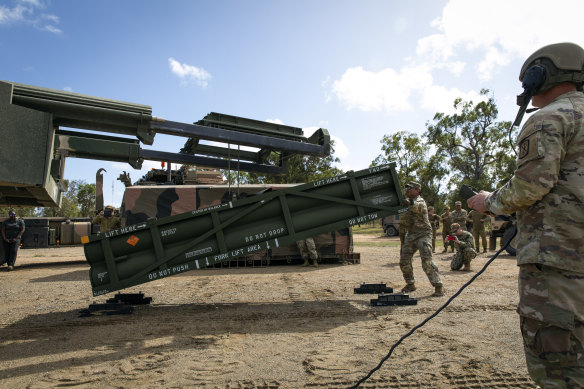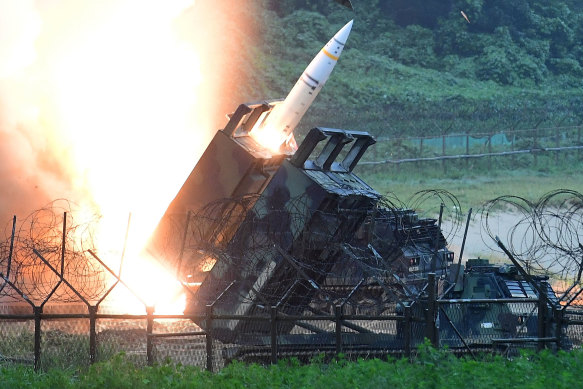What are ATACMS, the weapons Ukraine can now use against Russia
By John Ismay and Ephrat Livni
Washington: For the first time, the Biden administration has authorised Ukraine to use US-supplied ballistic missiles for attacks inside Russia, marking a major policy shift.
The missiles are known as Army Tactical Missile Systems, or ATACMS (pronounced “attack ’ems”). They are likely to be initially employed against Russian and North Korean troops to support Ukrainian forces in the Kursk region of western Russia, according to US officials.
Ukraine has been lobbying the United States for years to receive the authorisation, which comes in the final months of the Biden administration. President-elect Donald Trump has said he will seek a quick end to the war in Ukraine.

A Ukrainian artillery crew with the Bureviy Brigade fires on a Russian position, in the Luhansk region of Ukraine. President Joe Biden has authorised the first use of US-supplied long-range missiles by Ukraine for strikes inside Russia.Credit: Finbarr O’Reilly/The New York Times
What do these missiles do?
ATACMS, made by Lockheed Martin, are short-range ballistic missiles that, depending on the model, can strike targets 300 kilometres away with a warhead containing about 170 kilograms of explosives. Ballistic missiles fly much higher into the atmosphere than artillery rockets and many times further, coming back to the ground at incredibly high speed because of gravity’s pull.
They can be fired from the HIMARS mobile launchers that the United States has provided Ukraine, as well as from older M270 launchers sent from Britain and Germany.

An Army Tactical Missile System (ATACMS) test fire at Fort Bragg military base in North Carolina.Credit: AP
ATACMS are often referred to as “long-range missiles”, but that is a subjective term. They can reach further into Russia than any other Ukrainian missile but cannot travel as far as a cruise missile or intercontinental ballistic missile.
The ATACMS missile was developed in the 1980s to destroy high-value Soviet targets deep behind enemy lines. It was built as a rare guided weapon at a time when the US mainly relied on “dumb bombs” and other unguided munitions.
Today, the Pentagon has two versions of the ATACMS in its inventory – a cluster weapon and one that carries a single explosive charge.
Why did the US wait?
The decision about whether to arm Ukraine with ATACMS has been a sensitive subject since Russia’s full-scale invasion of Ukraine in February 2022. Since early in the war, Ukrainian President Volodymyr Zelensky has pleaded for weapons that can hit even deeper into Russian-held territory, and eventually into Russia itself.
The United States supplied Ukraine with ATACMS last year, but the Biden administration had until now withheld its approval for their use across the border into Russia.
The White House has been concerned that if Ukraine used the missile to strike targets deep inside Russia, Russian President Vladimir Putin might respond by escalating.
“We’re trying to avoid World War III,” President Joe Biden has said.

ATACMS for loading on to the High Mobility Artillery Rocket System at Williamson Airfield in Queensland last year.Credit: AP
Some Pentagon officials had also opposed giving these missiles to the Ukrainians because of limited supplies.
Zelensky says this kind of weapon is crucial to his country’s ability to launch a wider counteroffensive, and has insisted that he has no plans to strike Russian cities or target civilians.
On Sunday, he suggested in a nightly address that the US restriction had been lifted without confirming it, saying: “Such things are not announced. The rockets will speak for themselves.”
How will Ukraine use them?
The Russian military is preparing to launch a major assault by an estimated 50,000 soldiers, including North Korean troops, on dug-in Ukrainian positions in Kursk with the goal of retaking all of the Russian territory that the Ukrainians seized in August.
The Ukrainians could use the ATACMS to strike Russian and North Korean troop concentrations, key pieces of military equipment, logistics nodes, ammunition depots and supply lines deep inside Russia. That could help the Ukrainians blunt the effectiveness of the Russian-North Korean counteroffensive.
Last year, Biden agreed to supply several hundred ATACMS for use on Russian-held Ukrainian territory, including the Russian-occupied Crimean Peninsula. It is unclear how many of the missiles the Ukrainians have left in their arsenal to use in the Kursk region.
Has the US used them in combat?
The US military fired about 30 ATACMS in 1991 during Operation Desert Storm, according to government records. They were used to strike Iraq’s medium-range ballistic missile launchers and surface-to-air missile sites.
Those first-generation cluster munition versions could fly about 160 kilometres. Once over their targets, they released 950 bomblets.
The army also fired more than 400 of the bomblet-carrying tactical missiles in Operation Iraqi Freedom, according to government records, most notably in the early hours of the 2003 invasion.

A US Army Tactical Missile System firing a missile into the East Sea during a South Korea-US joint missile drill in South Korea in 2017.Credit: Getty Images
The Pentagon later restricted the use of cluster munitions because they often failed, littering battlefields with hazardous duds that killed and wounded soldiers and civilians after combat ended. The army refurbished many of the early ATACMS in the 2000s and replaced the bomblets with a single explosive warhead.
This article originally appeared in The New York Times.
Get a note directly from our foreign correspondents on what’s making headlines around the world. Sign up for our weekly What in the World newsletter.
Most Viewed in World
>read more at © Sydney Morning Herald
Views: 0